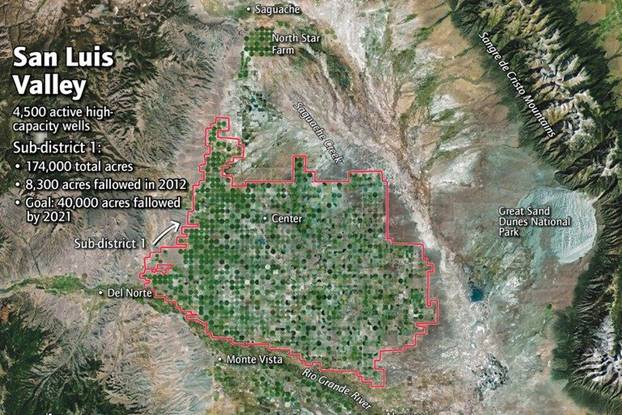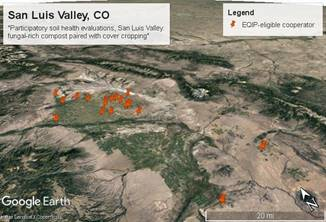In Colorado’s high-elevation, cold and extremely arid San Luis Valley, irrigated crop production involves mainly potatoes, spring-seeded small grains, and forage. The situation includes declining groundwater availability, increasingly variable weather, and a generally high cost of maintaining productive soils.
A devoted group of San Luis Valley farmers, crop advisers, soil scientists, and Natural Resource Conservation Service (NRCS) staff meet on a near-monthly basis, and have since 2010, to discuss soil health principles and locally adaptable practices. Agriculturalists’ interest in soil health remains strong, however severe drought, and prolonged overdraft of groundwater has growers questioning the economics of expending scarce water and growing-season time for cover crop use.
Local groundwater management authorities presently offer cost-share incentives for farmers to fallow their fields for twelve consecutive months so groundwater pumping may be curtailed. Such policies challenge the farmer intent on increasing biological diversity and maintaining a living root in the soil for longer. The immediate cash offer to fallow a field for the year is being balanced with the largely felt, but not farmer-quantified, economic impact of implementing soil health principles into the farming system. An especially difficult choice in present times of low commodity prices.
Soil amendment with locally available compost (which was actively turned and bacterial dominated) used to be cost-shared through EQIP in this valley as a soil health practice, but the EQIP cost share was discontinued. Over multiple years, many farmers weren’t seeing consistent effects, even from heavy, expensive application rates. To date the only commercially-available compost in the region continues to be an actively aerated, highly bacterial compost product.
Cover cropping, even with EQIP cost share on seed, has had limited adoption here (and in tilled systems in southwestern USA) due to perceived minor benefits towards soil health relative to cost, including the cost of pumping water from an overdrafted aquifer.
So what’s missing? What is limiting the effects of cover cropping and compost amendments? What is missing in our systems to achieve soil health, water use efficiency, and lowered costs of production? How might we work together to creatively fill these gaps?
In 2004 Colorado passed a law mandating the recovery of the aquifer under the valley. Water use efficiency, with 6-7 inch average rainfall, is a critical challenge.
What drives both crop productivity and soil health is the flow of sunlight energy. Photosynthesis produces carbohydrates, which feed soil biology, which in turn influences crop productivity, water retention and water use efficiency, and nutrient use efficiency—all of which are significant challenges in the San Luis Valley and in much of the arid western U.S.
Fungi and bacteria are the base of the soil foodweb, responsible for the majority of the decomposition of soil organic matter. They are key regulators of the enormous flow of sunlight energy through the soil system. Here’s a more technical explanation: The fungal/bacterial ratio in the soil microbiome influences what happens to plant photosynthates: whether they are partitioned into secondary-assimilated biomass or lost from the soil through respiration (Six et al. 2006). Higher fungal/bacterial ratios are associated with a higher quality and quantity of soil organic matter (Six et al., 2006), and also associated with observed variances in soil carbon use efficiencies (CUE). CUE is defined as the proportion of photosynthate C acquired from the environment that is used for growth (Bradford &, Crowther, 2013) or the conversion of plant-produced carbohydrates into microbial products (Sensabaugh, 2013). Values for CUE range between 0.10 to 0.80, with high CUE promoting greater amounts of secondary-C assimilation and higher levels of C stabilization in soils, while lower CUE indicates higher respiration of uptake C to CO2 and reduced levels of C stabilized in soils (Keiblinger et al., 2010). The magnitude of the differences between these low and high estimates of CUE have been observed to be a function of soil fertility, ecological factors, and microbial community composition, with higher-fertility soils and fungal-dominant microbial communities demonstrating higher CUE (Keiblinger et al, 2010, Comis, 2002, Sollins et al., 2009, Manzoni et al., 2013, Six et al., 2006).
Dr. David Johnson, a researcher at New Mexico State, has developed a static pile compost process (where the compost is not turned), resulting in fungal-dominated compost for use in low amounts per acre as an inoculant, increasing the fungal/bacterial ratio in soil. His research has observed the potential to improve:
- plant productivity (5 times increase in net primary productivity and a doubling of commodity crop production)
- soil health (improved soil nutrient availability, increased crop water use efficiency, and soil carbon use efficiencies) and
- a farmer’s bottom line (higher yields while using fewer nutrient and herbicide/pesticide inputs), when we focus our efforts on restoring the biological barter that can exist between a plant and its soil microbiome
In greenhouse and field trials in southern New Mexico, Johnson has recorded significantly higher productivity, water use efficiency, and nutrient use efficiency with these practices. But there has been limited deployment, particularly at field scale.
In January 2018 the Mosca-Hooper Conservation District hosted David Johnson’s presentations on the static-pile, fungal-dominated compost process, the importance of the soil fungal/bacterial ratio, the synergy with cover cropping, and the excellent results from trials. There was strong interest by farmers. Already in 2018, sixteen farmers have agreed to cooperate with the Mosca-Hooper Conservation District in making static pile compost, which takes a year to produce high-fungal compost suitable for low-rate (400 lbs./acre) inoculation applications to fields.
These farmers also want to combine the compost inoculation with cover cropping and gauge the effects of this combination. This is a co-creation or “chicken-plus-egg” strategy: Cover crops can supply energy flow into the soil microbial community between primary cash crops, but if this community remains highly bacterial, this energy is quickly lost. Higher fungal/bacterial ratios can slow the release of this energy and carbon, promoting crop productivity, water use efficiency, nutrient use efficiency, resilience to pests and diseases, and overall soil health.
Needs for innovation. There is a general lack of farmer training to do repeatable soil health assessments on their own fields, and to record these metrics in a way that is meaningful and accessible for future reference or repeated assessments, or with the option of sharing. Regionally adapted soil health metrics have been developed but are not widely utilized.
The absence of simple data management is a major impediment for farmer decision-making regarding crop, range, and conservation planning. There is also limited communication between farmers regarding benefits (or downfalls) of soil health monitoring, and its connection to productivity, cost of production, or soil function.
Most data and research results remain hidden from most people, from farmers, extension agents, from most stakeholders in natural resource issues. This is both a technical problem of access and research-centric data schemas, and a human problem of access, context, participation, and interpretation.
Objectives
- Improve productivity, water use efficiency, and lower the cost of maintaining soil fertility in irrigated cropland and forage production
- Build capacity among farmers and stakeholders to make soil health evaluations, learn, innovate, adapt, and spread soil health innovations
Innovative Approaches
- High-fungal compost application with cover cropping
- Open-source, flexible, citizen-usable data platforms that support research data collection as well as participatory soil health evaluations, and that support:
- A shared, collaborative, respectful, site-specific, evidence-based intelligence on soil health and function that promotes and spreads integrated, adaptive soil health management systems
NRCS Conservation Practice Standards into which our project metrics and outcomes could be integrated include:
138. Conservation Plan Supporting Organic Transition: based on identification of increased nutrient use efficiencies utilizing organic-qualifiable fungal-rich compost into crop and soil management plan, soil biological and physical testing to inform whether indications of system functionality are abundant,
identification of most useful soil testing suite for local conditions to answer questions of system functionality and potential for efficiency and productivity
317. Composting Facility: adaptation of facility and processes design to deliver economical and high-quality finished material
Conservation Cover: based on changes in soil physical properties including aggregate stability and bulk density relative to local soil &, environmental conditions, integration of soil fungal/bacterial ratio, duration of living root &, green cover, and percent total cover as planning considerations
Conservation Crop Rotation: based on duration of green cover &, living root, soil aggregate formation dynamics, water use efficiency, and likelihood of cover persisting relative to crop rotation sequence
340. Cover Crop: based on water use efficiency, duration of green cover &, living root, microbial dynamics of highest and lowest producing systems involving cover crops, nutrient use efficiency findings
345. Residue and Tillage Management, Reduced Till: adaptation of practice based on whether timing, intensity, and frequency of tillage relative to fungal-rich compost-treated cover crop growth impacts soil health metrics, system water use efficiency, and ground cover
449. Irrigation Water Management: based on changes in cropping system’s water use efficiency, soil bulk density and infiltration rates in response to incorporation of fungal-rich compost paired with cover crops
512. Forage and Biomass Planting: based on findings from project fields where crops were paired with fungal-rich compost and utilized for forage and/or grazing, relative to their capacity to cycle energy, increase carbon use efficiency, and improve water use efficiency
590. Nutrient Management Plan: based on findings of increased nutrient use efficiency from particular cropping systems, soil testing methods including fungal/bacterial ratio, low-cost microbial testing through biomarker determination to anticipate soil’s nutrient release capacity (metatranscriptome and rRNA 16S/18S to determine low-cost test for specific biomarkers)
595. Integrated Pest Management: integrating cover crop species &, cultivar specific logic relative to microbial associations they foster, to induce suppression of soilborne pathogens or increased prevalence of symbiotic/predatory microbial functional groups in soil, for tailoring pest management plans to manage soil microbiome of field towards more effective pest control, utilization of metatranscriptome and rRNA 16S/18S to inform potential impact of crop selection and management practices on pest management
610. Salinity and Sodic Soil Management: based on observations of salt-affected soils in response to fungal-rich compost addition to cover crop, soil chemical, physical and microbial properties relative to crop productivity and water &, nutrient use efficiency to inform practice standards
Methods
Both the objectives and methods of this project involve creative combinations. The Mosca-Hooper Conservation District seeks to leverage static-pile high-fungal compost inoculation, plus the demonstrated interest and commitment of 18 San Luis Valley farmers, with:
cover cropping to provide food for helping to improve the population, structure and biological functionality of the soil microbial community
lab analyses and research to convey changes in soil biological, physical, and chemical properties before and after the compost inoculation and cover cropping (both quantitative and qualitative) over a three year trial period.
Our method is not a linear path from a practice to a result, but an exploration of relationships: between soil biology, energy flow, economics of production, and our capacity to learn, share, and adapt, using the following methods and tools:
Fungal-dominant compost. Making enough static-pile compost for inoculation of 500 or so acres is already committed, and will be done with advice from David Johnson, as well as quality assurance and control through periodic lab testing.
Cover cropping between cash crops. Most of the 16 cooperator farms have committed 60 acres to the experiment which they will plant with multispecies cover crops. On half the acreage (30 in most cases), high-fungal compost inocula will be applied.
Farms participating in this project are commercial-scale family farm operations including conventional and certified organic, center pivot irrigated, with rotations counted here by the number of summers that would pass before the same crop is planted again, consisting of: green manure cover
crop-potato-barley (3 year), green manure cover crop-potato (2 year),
potato-winter triticale cover - spring wheat (2 year), potato-legume/cereal hay (2 year), potato-cereal rye spring grazed-multispecies cover winter grazed-green manure summer (3 year), perennial grass &, legume hay/pasture, alfalfa-legume/cereal hay (6 year).
Benefits
- Improved soil health and stability in San Luis Valley, along with increased crop production and cropping system water use efficiency.
- Social and human capital: trust, shared learning, and collaboration among farmers, partners, and those who have a stake in the agricultural economy of the San Luis Valley.
- Lasting impact: increased capacity in the San Luis Valley for integrated, adaptive management based on shared evidence, with increasing soil health, lowered cost of production, and increased water use efficiency.
References
Bradford, M.A., Crowther, T.W, 2013. Carbon use efficiency and storage in terrestrial ecosystems. New Phytol. 199(1), 7-9.
Chadwick, Bob. Finding New Ground (2013). This book, by a former US Forest Service Forest Supervisor, is a detailed and sensitive guide for facilitators, for creating and maintaining an environment “where people purposefully learn from each other, even from those with opposing views, and build a more comprehensive view from their interlocking realities, where this knowledge is applied to create not just ‘common ground’ but ‘new ground,’ where all can agree that their interests are taken care of and they behave the agreement, actually making it happen.” Chadwick was highly successful in helping people address natural resource conflicts and finding new ground throughout the West and Midwest during the 1990s and 2000s.
Comis, D., 2002. Glomalin: Hiding Place for a Third of the World’s Stored Soil Carbon.
Agric. Res. http://agresearchmag.ars.usda.gov/AR/archive/2002/Sep/soil0902.pdf
Johnson, David. Best management practices for Johnson-Su compost bioreactors. http://case.nmsu.edu/case/pasodelnorteagriculturalworkshops/documents/Joh nson-Su_Bioreactor_BMP.pdf
Keiblinger, K.M., Hall, E.K., Wanek, W., Szukics, U., Hammerle, I., et al., 2010. The effect of resource quantity and resource stoichiometry on microbial
carbon-use-efficiency. FEMS Microbiol. Ecol. 73, 430–440.
Manzoni, S., Taylor, P., Richter, A.,
Porporato, A., Agren, G.I., 2013. Environmental and stoichiometric controls on microbial carbon-use efficiency in soils. New Phytol. 196, 79–91.
Sensabaugh, R.L., Manzoni, S., Morhead, D.L., Richter, A., 2013. Carbon use efficiency of microbial communities: stoichiometry, methodology and modelling. Ecol. Let. doi: 10:1111/ele.12113.
Six, J., Frey, S.D., Thiet, R.K., Batten, K.M., 2006. Bacterial and Fungal Contributions to Carbon Sequestration in Agroecosystems. Soil Sci. Soc. Am. J. 70:555–569 (2006): 70(2), 555-569.
Sollins, P., Kramer, M.G., Swanston, C., Lajtha, K., Filley, T., Aufdenkampe, A.K., Wagai, R., Bowden, R.D., et al. 2009. Sequential density fractionation across soils of contrasting mineralogy: evidence for both microbial and mineral controlled soil organic matter stabilization. Biogeochemistry 96, 209-231.
Van der Ploeg, Jan Douwe, Piet Verschuren, Fran Verhoeven, and Jose Pepels. Dealing with novelties: A grassland experiment reconsidered. Journal of Environmental Policy &, Planning Vol. 8, No. 3, September 2006, 199–218. DOI:
10.1080=15239080600915568
Welke, Sylvia E. (2005) The Effect of Compost Extract on the Yield of Strawberries and the Severity of Botrytis cinerea. Journal of Sustainable Agriculture 25:1, 57-68. doi.org/10.1300/J064v25n01_06



